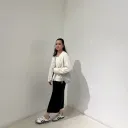Our favourite places to stay on this sleepy Cebu island.
Clark International Airport Bags 'Airport of the Year' Title in Asia

Clark International Airport in Pampanga, Philippines, has recently been honoured with the prestigious title of International Airport of the Year. This recognition, conferred at the 2024 TDM Travel Trade Excellence Awards, highlights the airport's significant contributions to the region and the whole country's travel and tourism industry since it first operated.
Also read: Where to Stay in Clark: 10 Best Hotels, Resorts, and Airbnbs For Your Next Weekend Break
Clark International Airport: A rising star

The airport has been commended for its innovative initiatives that have significantly boosted the economic development in Central Luzon. The airport's strategic location and modern facilities have made it a popular choice for both domestic and international travellers. By providing exceptional service and embracing cutting-edge technologies, the airport has positioned itself as a key player in Asia's highly competitive aviation landscape.
A vision for the future
Looking ahead, Clark International Airport aims to attract more airline partnerships and solidify its position as a world-class hub for seamless connectivity. By expanding its current network of destinations and further enhancing its facilities, the airport is poised to become a major gateway to the Philippines and the wider regions.
Also read: Philippine Airlines Announces New Clark to Batanes Route
This prestigious award is a testament to the airport's continuous dedication to excellence and its big potential to drive economic growth and tourism development in the Philippines. As Clark International Airport continues to soar to new heights, it is set to become a primary player in the global aviation industry.
All image credit goes to Clark International Airport
Published at
About Author
Patricia Caleon
Subscribe our Newsletter
Get our weekly tips and travel news!
Recommended Articles
10 Bantayan Island Resorts, Hotels, and Rentals for Your Tropical Escape 10 Best Banawe Restaurants for a Mouthwatering Food Trip in QC The promise of new flavours beckons from Banawe.
10 Best Mountain Cafes in the Philippines for Your Peak Coffee Experience Coffee date on the mountains, anyone?
10 Commandments for Responsible Travel Flexing Spread the good word!
10 Family Outing Ideas in Metro Manila Under ₱500 Looking for a weekend bonding with the family under ₱500? Head to these places, pronto!
Latest Articles
Boracay’s White Beach Named Among World’s Best Beaches in 2025 Global travel site ranks White Beach as a top 2025 destination
NAIA Fee Hike Sparks Concerns Over End of Promo Fares Rising airport fees may soon impact low-cost flight deals
Lost Ticket, Local Kindness, and the Legendary Kobe Beef: How The Poor Traveller Found Real Magic in Japan Heartwarming Japan travel moments
Nam Woo Hyun to Hold Solo Concert in Manila This November 2025 Solo K-pop concert happening in Taguig
₱500K Worth of Jewellery Goes Missing at NAIA, Later Recovered NAIA staff caught mishandling valuables

